A Step-by-Step Guide to Creating Tables

The Art of Crafting Clear and Concise Tables: A Comprehensive Guide

In the world of data presentation and analysis, tables are an indispensable tool. They offer a structured and organized way to convey information, making complex datasets accessible and understandable. Creating effective tables, however, is an art that requires careful planning and execution. In this comprehensive guide, we will walk you through the process of crafting tables that not only showcase your data but also enhance its impact and clarity.
Whether you are a researcher, a data analyst, or a content creator, understanding the intricacies of table creation is crucial. It allows you to communicate your findings, ideas, or comparisons in a visually appealing and easily digestible manner. So, let's embark on this journey, uncovering the steps and best practices to make your tables stand out and leave a lasting impression.
Step 1: Define Your Purpose and Data

The first step in crafting a compelling table is to define its purpose and the data it will represent. Ask yourself: What story do I want to tell with this table? Is it to compare different variables, showcase trends over time, or present a detailed analysis of a specific topic? Understanding the purpose will guide your table design and help you select the most relevant data.
For instance, imagine you are a market researcher analyzing consumer behavior. Your purpose might be to illustrate the popularity of various products across different age groups. You would then collect data on product sales, customer demographics, and potentially other relevant factors.
| Product | Age Group | Sales ($) |
|---|---|---|
| Product A | 18-24 | 1200 |
| Product B | 25-34 | 850 |
| Product C | 35-44 | 620 |
| Product D | 45-54 | 480 |
| Product E | 55-64 | 310 |

Step 2: Organize and Clean Your Data
Once you have collected your data, the next crucial step is to organize and clean it. This step is often overlooked but is essential for creating a clear and professional-looking table. Organize your data in a logical manner, ensuring consistency in formatting and naming conventions.
For our market research example, you might have collected data on multiple products and age groups. It's important to ensure that the data is consistent and that any outliers or errors are identified and addressed. Cleaning your data involves removing any irrelevant or duplicate entries and standardizing formats. For instance, if you have product names in various cases, ensure they are all in a consistent format (e.g., "Product A" instead of "product a" or "PRODUCT A").
| Product | Age Group | Sales ($) |
|---|---|---|
| Product A | 18-24 | 1200 |
| Product B | 25-34 | 850 |
| Product C | 35-44 | 620 |
| Product D | 45-54 | 480 |
| Product E | 55-64 | 310 |
Step 3: Choose an Appropriate Table Structure
Selecting the right table structure is critical to effectively presenting your data. The structure you choose should align with your purpose and the nature of your data. Consider factors such as the number of variables, the relationships between them, and the level of detail you want to showcase.
In our market research scenario, a simple table structure with columns for product names, age groups, and sales figures would suffice. However, if you were comparing multiple factors, such as sales across different regions or time periods, you might need a more complex structure with additional columns or rows.
| Product | Age Group | Sales ($) |
|---|---|---|
| Product A | 18-24 | 1200 |
| Product B | 25-34 | 850 |
| Product C | 35-44 | 620 |
| Product D | 45-54 | 480 |
| Product E | 55-64 | 310 |
Step 4: Add Headings and Labels

Clear and descriptive headings and labels are essential for guiding your audience through your table. They provide context and ensure that readers understand the content of each column or row. Use concise and informative labels that accurately describe the data being presented.
In our market research table, the headings "Product," "Age Group," and "Sales ($)" provide a clear indication of the data being displayed. Ensure that your labels are consistent and avoid any ambiguity. For instance, if you are comparing sales across multiple years, use headings like "Year 2022," "Year 2023," and so on, rather than vague labels like "Period 1" and "Period 2."
| Product | Age Group | Sales ($) |
|---|---|---|
| Product A | 18-24 | 1200 |
| Product B | 25-34 | 850 |
| Product C | 35-44 | 620 |
| Product D | 45-54 | 480 |
| Product E | 55-64 | 310 |
Step 5: Format Your Table for Clarity
Proper formatting is key to making your table visually appealing and easy to interpret. Consider the following formatting elements to enhance the clarity of your table:
- Alignment: Ensure that numerical data is right-aligned, while text-based data is left-aligned. This alignment makes it easier to compare values and read text.
- Borders and Lines: Use borders and lines to define the table's structure and separate rows and columns. This visual guidance improves readability, especially for complex tables.
- Cell Padding: Adjust cell padding to provide adequate spacing between content and cell borders. This prevents crowding and makes the table more inviting.
- Font and Size: Choose a clear and legible font, such as Arial or Calibri, and ensure the font size is large enough for comfortable reading. Consistency in font style and size throughout the table is crucial.
- Color and Highlighting: Use color and highlighting sparingly to draw attention to specific cells or sections. Avoid excessive use of colors, as it may distract from the data.
For our market research table, we might format it as follows:
| Product | Age Group | Sales ($) |
|---|---|---|
| Product A | 18-24 | 1,200 |
| Product B | 25-34 | 850 |
| Product C | 35-44 | 620 |
| Product D | 45-54 | 480 |
| Product E | 55-64 | 310 |
Step 6: Include Necessary Notes and Legends
To provide additional context and clarity, consider including notes and legends in your table. Notes can explain any abbreviations, units of measurement, or specific conditions that apply to the data. Legends, on the other hand, are particularly useful for color-coded tables, explaining the meaning of different colors or symbols.
For instance, if our market research table included data on product sales across multiple countries, we might add a legend to explain the color coding for each country. This would ensure that readers understand the geographic distribution of sales.
| Product | Age Group | Sales ($) |
|---|---|---|
| Product A | 18-24 | 1,200 |
| Product B | 25-34 | 850 |
| Product C | 35-44 | 620 |
| Product D | 45-54 | 480 |
| Product E | 55-64 | 310 |
|
Legend:
|
||
Step 7: Review and Edit for Accuracy and Consistency
Before finalizing your table, conduct a thorough review to ensure accuracy and consistency. Check for any errors, inconsistencies, or typos. Double-check your calculations and ensure that the data presented aligns with your original sources.
Consistency is key. Ensure that your table adheres to a consistent style and format throughout. This includes maintaining a consistent use of abbreviations, units of measurement, and formatting elements like font styles and sizes.
In our market research table, we might review and edit to ensure that sales figures are accurate and that the age groups are presented consistently. We would also ensure that the table's overall design and layout remain cohesive.
| Product | Age Group | Sales ($) |
|---|---|---|
| Product A | 18-24 | 1,200 |
| Product B | 25-34 | 850 |
| Product C | 35-44 | 620 |
| Product D | 45-54 | 480 |
| Product E | 55-64 | 310 |
|
Legend:
|
||
Step 8: Finalize and Present Your Table
Once you have meticulously crafted your table, it's time to finalize and present it. Ensure that your table is appropriately sized and positioned within your document or presentation. Consider the context in which it will be viewed and ensure it aligns with the overall design and style.
If your table is particularly long or complex, consider breaking it into smaller sections or providing a summary version alongside the detailed table. This can make it more digestible for your audience and allow them to quickly grasp the key insights.
In our market research example, we might present our table alongside a brief summary of key findings. This summary could highlight trends, such as the popularity of certain products among specific age groups or the overall sales performance across different regions.
| Product | Age Group | Sales ($) |
|---|---|---|



